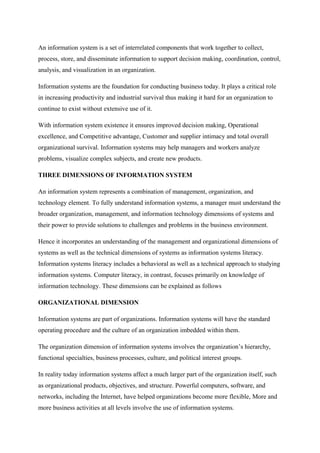
Three Dimensions of Information Systems
- 1. An information system is a set of interrelated components that work together to collect, process, store, and disseminate information to support decision making, coordination, control, analysis, and visualization in an organization. Information systems are the foundation for conducting business today. It plays a critical role in increasing productivity and industrial survival thus making it hard for an organization to continue to exist without extensive use of it. With information system existence it ensures improved decision making, Operational excellence, and Competitive advantage, Customer and supplier intimacy and total overall organizational survival. Information systems may help managers and workers analyze problems, visualize complex subjects, and create new products. THREE DIMENSIONS OF INFORMATION SYSTEM An information system represents a combination of management, organization, and technology element. To fully understand information systems, a manager must understand the broader organization, management, and information technology dimensions of systems and their power to provide solutions to challenges and problems in the business environment. Hence it incorporates an understanding of the management and organizational dimensions of systems as well as the technical dimensions of systems as information systems literacy. Information systems literacy includes a behavioral as well as a technical approach to studying information systems. Computer literacy, in contrast, focuses primarily on knowledge of information technology. These dimensions can be explained as follows ORGANIZATIONAL DIMENSION Information systems are part of organizations. Information systems will have the standard operating procedure and the culture of an organization imbedded within them. The organization dimension of information systems involves the organization’s hierarchy, functional specialties, business processes, culture, and political interest groups. In reality today information systems affect a much larger part of the organization itself, such as organizational products, objectives, and structure. Powerful computers, software, and networks, including the Internet, have helped organizations become more flexible, More and more business activities at all levels involve the use of information systems.
- 2. There is a growing interdependence between the organization and its information systems. An organization’s present and future accomplishments depend in many respects on what its systems will permit it to do now and later, thus a change in the business's strategy, rules, or procedures requires changes in the information systems software, hardware, databases, and telecommunications. MANAGEMENT DIMENSION OF INFORMATION SYSTEM Managers perceive business challenges in the environment, they set the organizational strategy for responding and allocate the human and financial resources to achieve the strategy and coordinate the work. The management dimension of information systems involves leadership, strategy, and management behavior. Information systems supply tools and information needed by managers to allocate, coordinate and monitor their work, make decisions, create new products, and services and make long-range strategic decisions. Information system helps to make teamwork and collaborative work environments Information systems help to drive both daily operations and managerial strategies. Information systems can help management to obtain periodic reports, These reports can be obtained from different systems such as sales./marketing systems, Human resource systems, accounting systems. The systems assist managers in making decision making such as by having What-if" questions on decision support systems. Also helps senior management to tackle and address strategic issues and long-term trends both in the firm and in the external environment. Their principle concern is matching changes in the external environment with existing organizational capability TECHNOLOGY DIMENSION The technology dimensions consist of computer hardware, software, data management technology, and networking/telecommunications technology (including the Internet). Management uses technology (hardware, software, storage, and telecommunications) to carry out their functions. It is one of the many tools managers use to cope with change.
- 3. Computer hardware is the physical equipment used for input, processing, and output activities in an information system. It consists of the following: the computer processing unit; various s input, output, and storage devices; and physical media to link these devices together. Computer software consists of the detailed preprogrammed instructions that control and coordinate the computer hardware components in an information system. Storage technology includes both the physical media for storing data, such as magnetic or optical disk or tape, and the software governing the organization of data on these physical media. Communications technology, consisting of both physical devices and software, links the various pieces of hardware and transfers data from one physical location to another. Computers and communications equipment can be connected in networks for sharing voice, data, images, sound, or even video All of these technologies represent resources that can be shared throughout the organization and constitute the firm's information technology (IT) infrastructure re. The IT infrastructure provides the foundation or platform on which the firm can build its specific information systems. Each organization must carefully design and manage its information technology infrastructure so that it has the set of technology services it needs for the work it wants to accomplish with information systems.
- 4. REFERENCES Laudon, K. & Laudon, J. (2006); Management Information Systems: Managing the Digital Firm, 9th edition. Prentice Hal http://www.aiu.edu/publications/student/english/Management%20Information %20Systems.htm (Accessed 24th march 2015)
